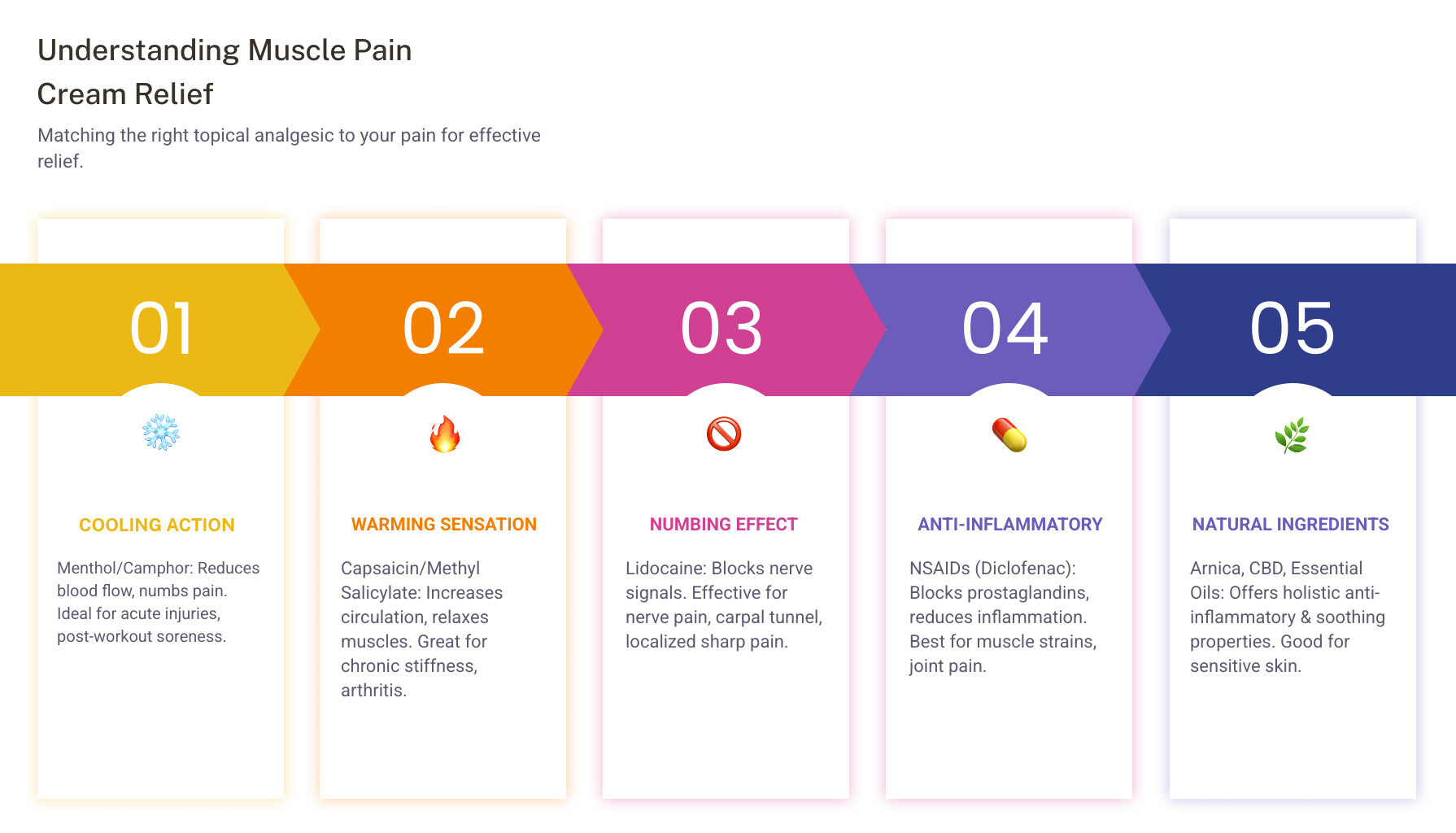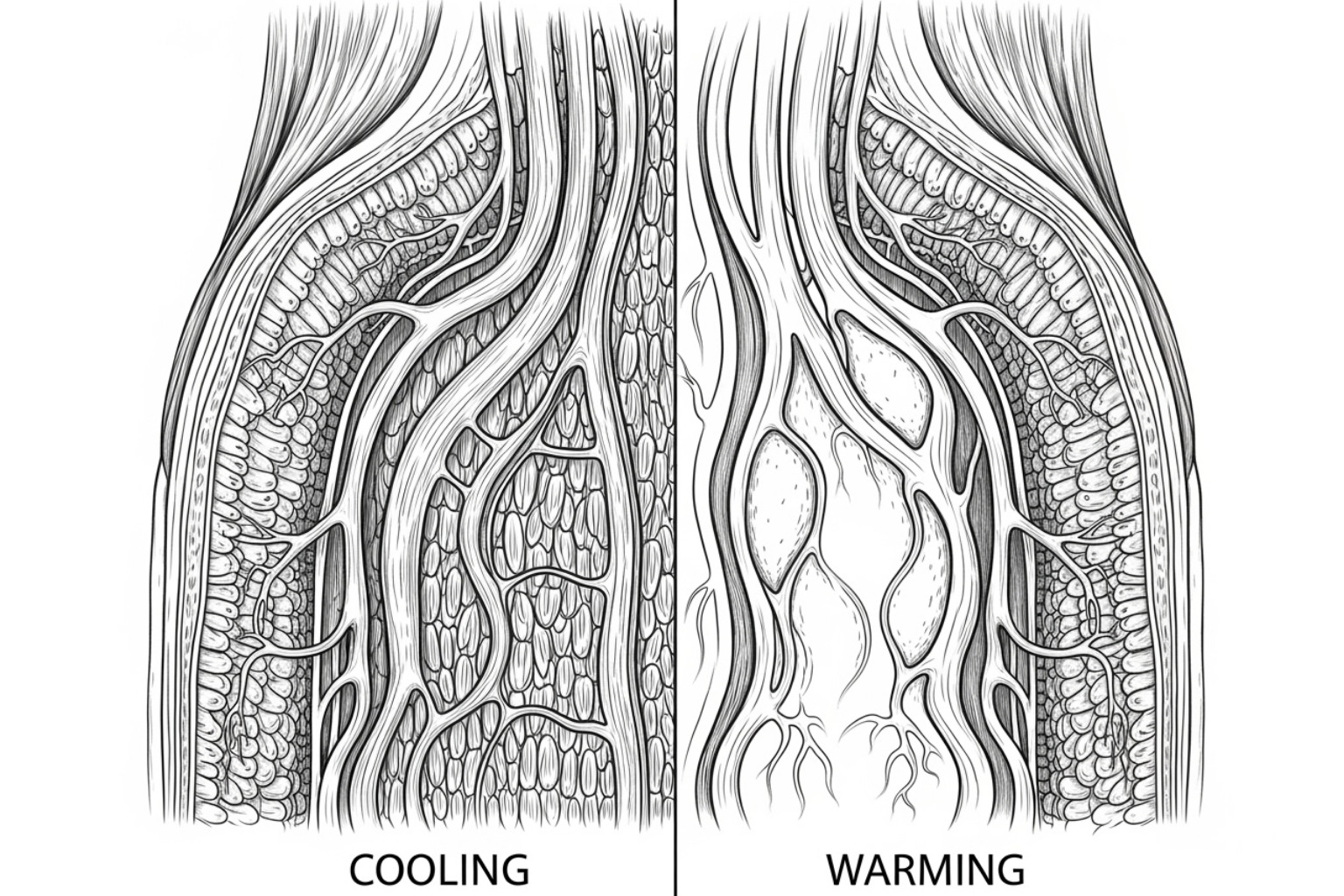Why Choosing the Right Muscle Pain Cream Matters
Muscle pain cream can provide fast-acting relief for sore muscles, but with dozens of options containing different active ingredients and formulations, finding the right one for your specific needs requires understanding what actually works.
Top muscle pain cream types and their best uses:
- Cooling creams (menthol, camphor) - Best for acute injuries, post-workout soreness, and reducing swelling
- Warming creams (capsaicin, methyl salicylate) - Best for chronic stiffness, arthritis, and pre-activity muscle preparation
- Numbing creams (lidocaine) - Best for nerve pain, carpal tunnel, and localized sharp pain
- Anti-inflammatory creams (diclofenac, ibuprofen) - Best for muscle strains, sprains, and joint inflammation
- Natural ingredient creams (arnica, CBD, essential oils) - Best for sensitive skin and holistic pain management
Whether you're dealing with post-workout soreness, chronic joint stiffness, or acute muscle strain, the key is matching the right active ingredients to your specific type of pain. Research shows that topical analgesics work by penetrating the skin to reduce inflammation, block pain signals, or provide cooling and warming sensations that distract from the underlying discomfort.
As Dr. Brad Whitley explains, these topicals "interfere with the neural pathways responsible for transmitting pain signals from your body parts to your brain, minimizing the perception of soreness." The effectiveness varies greatly depending on the chemical strength, location, and type of pain you're experiencing.
I'm Tony Enrico, and I've spent years researching and developing advanced formulations for topical pain relief, including work on muscle pain cream solutions that combine natural ingredients like menthol, aloe, and urea for fast-acting, long-lasting relief. This guide will help you steer the complex world of muscle pain creams to find the most effective option for your specific needs.

How Do Topical Muscle Pain Creams Work?
Ever wonder why rubbing a muscle pain cream on your sore shoulder actually makes it feel better? It's not just wishful thinking – there's real science behind that relief, and it starts with something called the gate control theory of pain.
Here's how it works: your nervous system is like a busy highway of signals traveling between your body and brain. When you apply a topical analgesic, you're essentially creating a traffic jam of sensations. The cooling, warming, or tingling feelings from the cream flood your nerve pathways with new signals, effectively crowding out some of those pain messages trying to reach your brain.
Think about what you do when you stub your toe – you automatically rub it, right? That rubbing creates competing sensations that help "close the gate" on pain signals. Muscle pain creams work on this same principle, but they're much more sophisticated about it.
These creams don't just mask pain – they actively stimulate your skin and distract your nervous system. The counterirritants in the cream create sensations that your brain pays attention to instead of focusing solely on the underlying ache or soreness.
But there's more to the story. Many muscle pain creams also contain ingredients that tackle inflammation directly or provide numbing effects. This dual approach – distracting the nervous system while addressing the source of discomfort – makes topical treatments surprisingly effective for mild to moderate muscle pain.
The key is that these creams work best on muscles close to the surface of your skin, where the active ingredients can really penetrate and do their job.

The Cooling Effect for Acute Pain
When you've just twisted your ankle, pulled a muscle during your workout, or are dealing with sudden, sharp pain, cooling muscle pain cream becomes your best friend. The star players here are menthol and camphor – two ingredients that create that refreshing, icy sensation we associate with immediate relief.
Menthol, often sourced from peppermint, does something pretty clever. It triggers cold receptors in your skin, creating a cooling sensation that helps numb the pain. At the same time, it causes vasoconstriction – basically, it makes your blood vessels tighten up, which reduces blood flow to the area and helps decrease swelling.
Camphor works alongside menthol as another counterirritant, adding to that cooling, numbing effect. Together, these ingredients create a powerful one-two punch against acute pain and inflammation.
This cooling approach is perfect for sprains and strains, post-workout recovery, and any time you need to reduce swelling quickly. Many popular cooling formulas are built on this principle, and for good reason – it works fast when you need relief now.
The decreased blood flow from cooling creams also helps reduce that throbbing sensation you get with fresh injuries, giving your body a chance to start healing without constantly sending pain signals to your brain.
The Warming Sensation for Chronic Stiffness
Now, if you're dealing with ongoing stiffness, arthritis pain, or muscles that feel tight and achy day after day, warming muscle pain cream takes a completely different approach – and it's exactly what chronic pain often needs.
Capsaicin is the heavy hitter in warming creams. This compound, which gives chili peppers their heat, creates a warming sensation that actually helps block pain signals over time. It's particularly effective for chronic conditions because it works on the pain pathways themselves.
Methyl salicylate is another warming agent that increases blood flow through vasodilation – the opposite of what cooling creams do. This increased circulation brings fresh oxygen and nutrients to stiff, achy muscles while helping carry away inflammatory compounds that contribute to chronic pain.
The warming effect helps relax muscles and soothe stiffness, making movement easier and less painful. This is why many people with arthritis find warming creams so helpful – the gentle heat helps loosen up those stubborn, stiff joints.
Some athletes swear by applying warming creams before activity too. The increased blood flow helps prepare muscles for exercise, potentially reducing injury risk. The best warming creams provide a controlled, therapeutic warmth that penetrates deep without being overwhelming.
The beauty of warming creams is that they work with your body's natural healing processes, encouraging better circulation and muscle relaxation rather than just numbing the problem away.
Key Ingredients to Look for in a Muscle Pain Cream
When you're standing in the pain relief aisle feeling overwhelmed by dozens of options, remember this: the secret to finding an effective muscle pain cream lies in understanding what's actually inside the tube. The active ingredients are what separate the products that truly work from those that just smell medicinal.
Think of it this way – you wouldn't buy a car without knowing what's under the hood, right? The same logic applies to topical pain relievers. Whether you're drawn to time-tested synthetic compounds or prefer the gentler approach of natural ingredients, knowing what each type brings to the table helps you make a choice that actually matches your pain relief needs.

Counterirritants: The Classic Cooling & Warming Agents
If you've ever used a muscle pain cream that made your skin tingle, you've experienced the magic of counterirritants. These ingredients work on a beautifully simple principle: they create just enough surface sensation to distract your brain from the deeper ache beneath.
Menthol is the cooling superstar you'll recognize instantly. Found in many popular cooling rubs, this mint-derived compound creates that refreshing sensation that seems to pull heat right out of inflamed tissue. Some over-the-counter products pack an impressive 10.5% menthol concentration – one of the strongest you can get without a prescription. When acute pain strikes after a tough workout or minor injury, menthol's cooling effect helps reduce blood flow and provides that blessed numbing sensation.
Camphor often teams up with menthol to amplify the cooling effect, though it can also provide warming sensations depending on how it's formulated. Some classic pain-relieving ointments combine high concentrations of both camphor and menthol, creating a powerful one-two punch that's helped people manage sore muscles for generations. That distinctive medicinal scent? That's camphor working its magic.
For those dealing with chronic stiffness or arthritis, methyl salicylate brings the heat. This aspirin-related compound, found in many heat rubs, works by increasing blood flow to tight, achy areas. The gentle warming sensation helps relax stubborn muscles and makes movement feel easier.
These counterirritants essentially create what scientists call "soothing surface irritation" – strong enough to disrupt pain signals from conditions like arthritis, but gentle enough to provide comfort rather than distress. Research shows how these mechanisms work at the molecular level: Scientific overview of counterirritants.
Anesthetics: Numbing the Pain Signals
Sometimes distraction isn't enough – you need to temporarily turn off the pain switch entirely. That's where topical anesthetics shine, literally blocking nerve signals before they can reach your brain.
Lidocaine is the heavy hitter in this category, available over-the-counter at up to 4% strength. This remarkable compound works by blocking sodium channels in nerve cells, essentially putting them to sleep temporarily. Many numbing creams and patches harness lidocaine's power for targeted relief.
What makes lidocaine particularly valuable is its versatility. Research shows it can help with diabetic peripheral neuropathy, carpal tunnel syndrome, chronic lower back pain, and osteoarthritis – conditions where other topical ingredients might fall short. You can find it in various formats, including fragrance-free roll-ons that offer a no-mess application for hard-to-reach spots.
The numbing effect isn't just masking pain – it's genuinely interrupting the communication between injured tissue and your brain. For deeper insight into how effective this can be, check out this comprehensive research: Research on topical lidocaine for pain.
NSAIDs: Fighting Inflammation Directly
When pain comes with visible swelling or that deep, throbbing ache that screams "inflammation," topical NSAIDs (non-steroidal anti-inflammatory drugs) tackle the problem at its source rather than just masking symptoms.
Diclofenac, the star ingredient in many anti-inflammatory gels, works by blocking prostaglandin production – those chemical messengers that trigger inflammation and amplify pain signals. Unlike oral NSAIDs that affect your entire system, topical versions deliver anti-inflammatory power directly where you need it most, making them a popular choice for back and muscle pain.
Ketoprofen operates through similar mechanisms, inhibiting the COX-2 enzyme responsible for inflammatory responses. These topical NSAIDs are particularly effective for localized arthritis and muscle strains because they address the underlying inflammation rather than just providing distraction.
The beauty of topical NSAIDs is their targeted action – you get the anti-inflammatory benefits without the stomach upset that sometimes comes with oral versions. This study provides excellent insight into their effectiveness: Study on topical NSAIDs.
Natural Ingredients in Your Muscle Pain Cream
Nature has been providing pain relief long before synthetic chemistry came along, and many people find natural ingredients gentler on sensitive skin while still delivering impressive results.
Arnica has earned its reputation through centuries of use for bruises, trauma, and tissue injuries. Derived from the Arnica montana plant, this natural anti-inflammatory may be comparable to ibuprofen for certain types of pain relief. Many popular natural pain relief creams feature arnica as a primary active ingredient, and research supports its traditional uses: Effectiveness of topical Arnica.
Capsaicin from hot peppers does double duty – it provides that warming sensation while also depleting Substance P, a neurotransmitter involved in pain signaling. This makes it particularly effective for chronic pain conditions where long-term relief matters more than immediate comfort.
CBD (Cannabidiol) has emerged as a fascinating option for those seeking natural inflammation control. This non-psychoactive cannabis compound interacts with our body's endocannabinoid system to help regulate immune responses and pain perception. Many topical products now offer broad-spectrum hemp extract for those wanting to explore this natural approach.
Turmeric brings curcumin to the table – a compound with well-documented anti-inflammatory effects. Some holistic balms combine turmeric with CBD and other natural ingredients for a comprehensive approach to pain management.
Essential oils add their own therapeutic benefits: peppermint oil provides natural menthol for cooling relief, eucalyptus oil offers anti-inflammatory and analgesic properties, while lavender oil brings calming effects that help ease muscle tension.
At Neuropasil, we've harnessed these natural principles in our unique formulations. Our muscle pain cream combines the cooling power of menthol with skin-nourishing aloe and urea to create fast-acting relief that our customers rely on for everything from neuropathy and sciatica to fibromyalgia and plantar fasciitis. Athletes particularly appreciate how our natural blend helps with post-workout recovery, treating sore muscles without harsh synthetic additives.
Comparing Formats: Creams, Gels, Roll-Ons, Sprays, and Patches
Beyond the ingredients, the way a muscle pain cream is delivered can significantly impact our experience and the product's effectiveness. Different formats offer unique advantages in terms of application, absorption, and convenience. Choosing the right format often comes down to personal preference and the specific area you need to treat.
| Format | Application | Absorption | Best For | Potential Cons |
|---|---|---|---|---|
| Creams | Massage into skin | Moderate, requires rubbing | Large areas, dry skin | Can feel greasy |
| Gels | Spreads easily | Quick, non-greasy | Quick relief, athletic use | May dry out skin |
| Roll-ons | No-mess applicator | Good penetration | Targeted spots, travel | Limited coverage area |
| Sprays | Hands-free application | Fast-drying | Hard-to-reach areas | Less precise targeting |
| Patches | Stick and forget | Slow, sustained release | All-day relief | May cause skin irritation |
The beauty of today's muscle pain cream market is that we're not limited to just traditional creams. Each format has been designed to solve specific problems, whether that's reaching your upper back without help or avoiding messy hands before an important meeting.
Creams and Balms
Traditional creams and balms remain popular for good reason. Their thicker consistency means they stay put once applied, making them perfect for massaging into larger areas like your back, shoulders, or legs. The massage action itself can be therapeutic, helping to work the active ingredients deeper into the tissue while providing additional pain relief through manual stimulation.
Many creams also include moisturizing ingredients, which can be a bonus if you're dealing with dry or sensitive skin. Classic warming rubs and cooling balms are great examples that have stood the test of time. The downside? They can feel greasy or heavy on the skin, and you'll definitely want to wash your hands thoroughly after application.
Gels
If you're looking for quick absorption without the greasy feel, gels might be your perfect match. These lighter formulations spread easily and absorb rapidly, often providing an immediate cooling sensation that many people find refreshing. The non-greasy texture means you can apply them and get dressed without worrying about staining your clothes.
Popular cooling gels and anti-inflammatory gels are excellent examples of how effective these formulations can be. Athletes particularly love gels because they can apply them quickly before or after workouts without the mess. The trade-off is that some gels can be drying to the skin with repeated use.
Roll-Ons and Sprays
When convenience is king, roll-ons and sprays shine. These formats are perfect for those hard-to-reach spots or when you need targeted relief without getting your hands messy. Roll-ons offer precise application with good penetration, making them ideal for travel or office use.
Sprays take convenience even further. They're fantastic for treating your upper back without assistance and dry quickly, so you're not left with wet spots on your clothing. The main limitation is that both formats work best for smaller, targeted areas rather than broad muscle groups.
Patches
For those who want to "set it and forget it," patches offer the best convenience. These adhesive applications provide sustained relief over hours, making them perfect for all-day comfort during work or sleep. Medicated patches are a popular choice because they're discreet and don't leave any residue on your hands.
The sustained-release mechanism means you get consistent pain relief without reapplication. However, some people find that patches can cause skin irritation with extended use, and they're not suitable for hairy areas where adhesion might be poor.
The key is matching the format to your lifestyle and pain pattern. If you're dealing with chronic stiffness that needs all-day attention, a patch might be ideal. For post-workout soreness that needs quick cooling relief, a gel could be your best bet.













